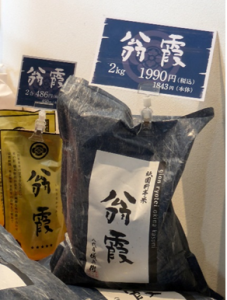Japanese people’s commitment to rice ~ what is delicious rice? ~
Yoshie Doi

I was surprised. I visited the rice store and listened to their story about rice. I was surprised at how revolutionary the Hachidaime Gihei Rice Store was. In early August, I visited this rice store, which is dedicated to the pursuit of “what is truly delicious rice,” and discovered that they had established a brand strategy that was far from common sense.
I had assumed that rice shops would buy rice by brand, such as “Koshihikari” or “Akitakomachi,” but that’s not the case. Apparently they have a discerning eye for rice, and decide which rice to buy by tasting “this rice from this field” every year. This in itself is revolutionary. They personally check the weather and quality of rice produced in rice-producing areas around the country, and then delicately blend the selected rice, polishing it so that you can enjoy every aspect of it, including its smooth texture, whiteness, luster, aroma, sweetness, stickiness, and texture.
This long-established rice store was founded in 1787, during the Kansei Reforms of the Edo period, and handles 200 tons of rice per month. We are impressed by their determination to discover new value in rice and continue to pursue the finest quality rice.
It is customary to purchase from the same producer every year, but Gihei VIII does not do that. The head of the family tastes the rice and judges its quality each year. It is a difficult task, and one needs to have a keen sense to be able to judge the quality.
Kyoto is a city of connoisseurs, but I am glad that the word “rice restaurant” was coined to promote the deliciousness of rice and that it is supported by the younger generation. “Rice restaurant” is also a registered trademark, appealing to the genes of Japanese people who have made rice their staple food. You can’t understand the chewy texture unless you try it.
It is said that rice tastes better if you store it in the vegetable compartment of the refrigerator, wash the rice by squeezing and releasing the rice 40 times, soak it in the refrigerator for an hour, and cook it in the quick cook mode. I heard that soaking the rice in the refrigerator for an hour is important so that the rice does not get stressed, so I tried it right away. It’s something that you don’t usually do, but with a little ingenuity, I hope you can enjoy delicious rice.
I have heard from Kyo-Suzume staff, including those with experience in rice farming and cooking, and from the Okudosan Mirai-shu that delicious rice is 50% rice itself and 50% cooking method. Many rice fields in Japan are terraced, and the rice harvested in these fields is delicious, and rice harvested after the full moon is delicious, and factors such as the period of drying in the sun are also taken into consideration. I think there was know-how for making delicious rice that has been passed down since ancient times. If rice is like a child, I have heard that the best rice is cooked in a hearth (Okudosan, Hettsui) (classified as Nanjing Kudo or Western Kudo) using straw as fuel. As for fuel, it is said that the best kind of rice is kinako roasted over a parent tree and ground in a stone mill, and Canadian maple syrup is boiled and condensed using the parent maple tree as fuel. The Okudosan Summit is also working on delicious rice.
The end of document
Translated by Masami Otani
